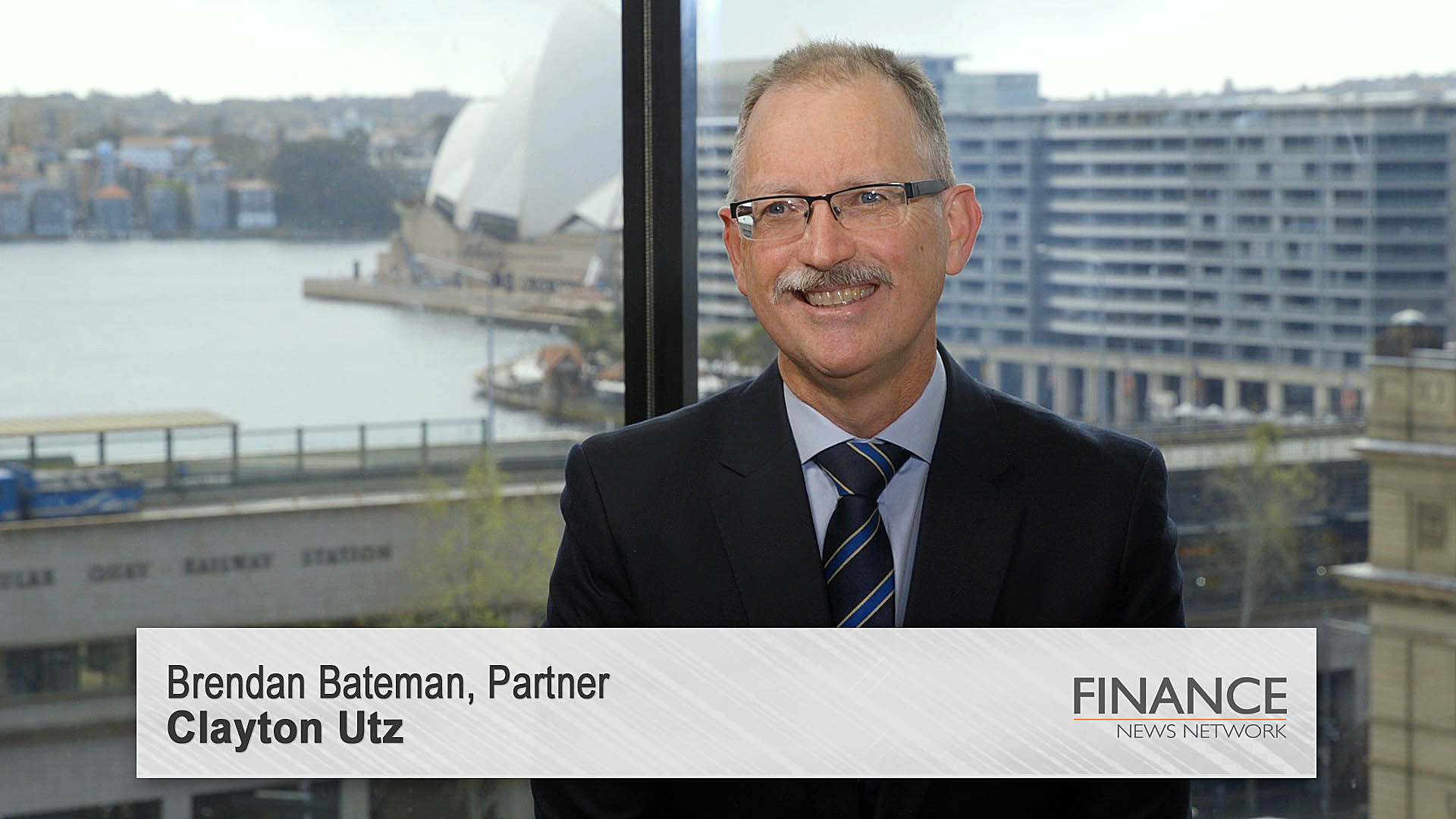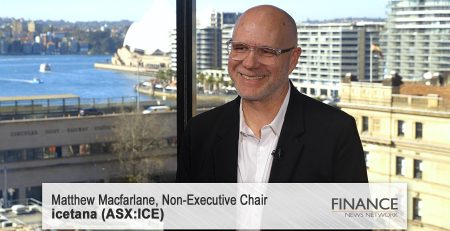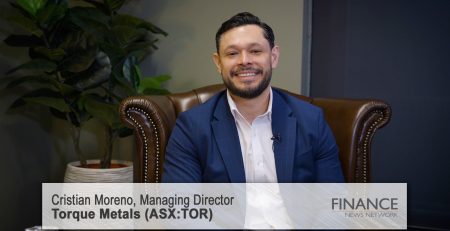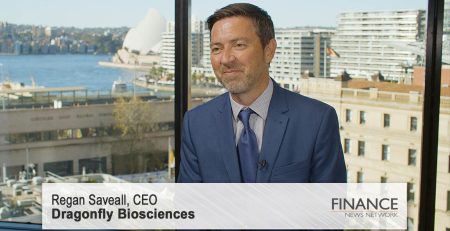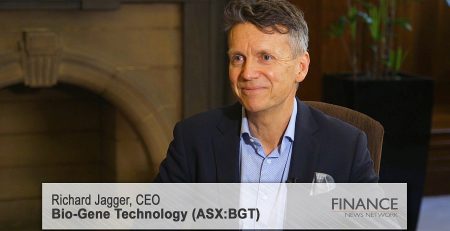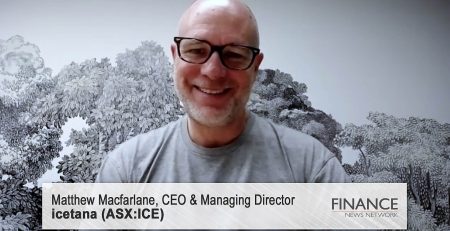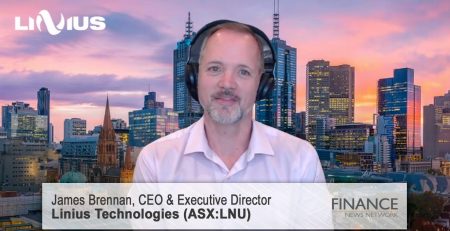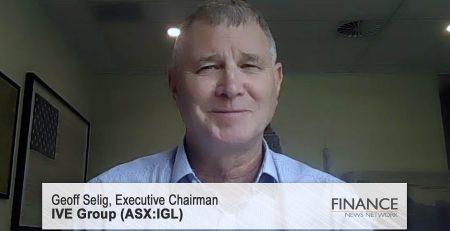Factoring climate change risks into financial valuations
Clayton Utz Partner Brendan Bateman discusses climate change risks, the legal duties of directors and how to factor such risks into financial valuations.
Katina Bullock: Hello. Katrina Bullock, for the Finance News Network. And joining me in the studio today is Brendan Bateman, a partner of top-tier commercial law firm Clayton Utz, and head of the law firm's climate change and sustainability group. Brendan was also a founding director of the Carbon Market Institute, a co-chair of the Australian Legal Sector Alliance, and one of my former ex colleagues from my days as a private practice lawyer. Brendan, lovely to have you on the network.
Brendan Bateman: Delighted to be with you, Katrina.
Katina Bullock: Absolute pleasure. Now, first and foremost, could we get you to talk us through the types of risks that Australian companies are facing as a result of climate change?
Brendan Bateman: Generally, the types of risk fall into two categories, physical and also transitional. However, I like to add in a third one, which is liability risk.
So, if we were to think about those categories, going back to physical, the physical is in relation to climate change impacts arising from weather events, similar types of events. Those impacts can be impacts on assets and properties. So, direct physical impacts and damage suffered on those assets. Can be impacts on trade chains, or supply chains. It can also be impacts on workforces and the ability of workforces to work in particular environments. And a good example was the recent bushfire season that we suffered. There's also issues associated from physical events on the cost and availability of supplies and inputs into supply chains as well. That's physical.
The second category is then the transitional risks. The transitional risks of a business associated with climate change are related to the transition of our economy to a low-carbon economy or a net-zero emissions economy. And those transition risks can be many. So, for example, you've got the risk of regulatory intervention and regulatory changes occurring over not just the short term, but over the longer term. What's the trajectory? What's the intention of the government to deal with climate-related risk? There's also risks associated with obtaining project approvals, or indeed obtaining project approvals on acceptable conditions. And we've had many recent examples, particularly in the energy resource sectors, where that has been particularly challenging for proponents in terms of dealing with climate-related risk in the assessment and the approval process for those particular projects.
There's also potential issues with markets in your ability to supply goods and services into particular markets. And we've had Europe announce that there's a potential for them to explore a border adjustment tax, a carbon tax, to impose on imports from countries that don't have equivalent carbon emission reduction targets as Europe does. There's also impacts on asset values. And there's also just simple reputational or social risks. So, the difference between the leaders in dealing with climate-related risks, and those are the laggards, those that are resisting change.
So they’re a number of the transitional risks that businesses are exposed to.
Finally, and the one that I like to refer to as the liability risk. Essentially, that's many risks associated with not foreseeing the risks associated with climate-related events on a particular business or a particular asset.
So, for example, you've got corporate disclosure obligations, and whether or not there's been compliance with those corporate disclosure obligations. And so there's the risk of shareholder and regulatory action in relation to those. You've also got issues associated with greenwashing. So, what we're finding now, a lot of businesses are trying to deal with climate change and trying to address them in a public way. And so they're grappling with the issue about how they assess the risk and then how they disclose it publicly, and how they present themselves to their customers. And so there's issues and risks associated with the greenwashing as well. And then finally, there's also just the risks associated with failing to foresee a real risk associated with a particular climate event that might impact on a business or a particular asset. And the failure of the business in that case, or the directors indeed, to have regard to that and making decisions associated with what they invest in.
Katina Bullock: Now, you've touched on something really interesting there. We've seen climate change risks drive increasing shareholder engagement this AGM season. Which naturally begs the question, are Australian directors legally required to take climate change risks into account in order to discharge their directors duties?
Brendan Bateman: I think the short answer to that is yes. Indeed, both at common law and under statute, directors have duties of care and diligence in relation to the best interests of their company and their business. So, from that point of view, it covers all manner of risks associated with business operations. That having been said, we've obviously seen an emergence of climate change as a real issue over the last several decades. And I think to the extent that it was always embodied within that general duty, it's now come to the fore. And I think that was clearly made by the Noel Hutley and Sebastian Hartford-Davis opinion in 2016 for the Centre for Policy Development. Which effectively said that directors of companies have duties to foresee risks to their business, and that includes climate change. And indeed concluded that it was only a matter of time before directors could be held liable for failing to have regard of foreseeable risks arising from climate change.
I think what we've been seeing over the last few years is actually an elevation of the standard expected of directors. So, there is no doubt now that directors do have an obligation to consider climate-related risks. Now it's an expectation about the standard of their understanding of climate-related risks and how they go about identifying, assessing and mitigating climate-related risks for their particular business.
And that elevation of the standard, I think, has been made apparent by some of the regulatory interventions that we've seen over the last two years. So, you've had ASIC in their Report 593 in relation to climate-related disclosures for ASX companies find that the quality of disclosure is actually quite poor. And in their corporate plan that they've recently released for this year and the next financial year, they're going to be focusing on climate change as one of those compliance-related issues. We have also seen APRA issue guidance earlier this year in relation to what's expected of regulated entities in terms of climate-related risk and financial impact disclosure that needs to be made. And you've also seen the corporate governance principles updated by the ASX in relation to what's expected of climate-related disclosures in information memoranda and so on.
So, those regulatory interventions clearly show that this is a first-order issue that businesses need to grapple with. And that's been reinforced again by that supplementary opinion that's been issued by Noel Hutley just last year in relation to that elevation of standard. That the quality and expectations of directors has increased quite considerably.
Katina Bullock: And Brendan, is it fair to say that there has been a shift in climate change litigation, with litigants now looking to hold companies and governments directly liable for climate change impacts?
Brendan Bateman: Certainly there's movement in that direction. So, whereas historically it always tended to be challenges to project approvals on judicial review grounds about failure to consider climate-related issues when granting those approvals. And so that goes back to, say, the Redbank Power Station case in the 1990s. We're still seeing those now. So, we see those in relation to Adani, for example. But we're seeing a different type of cases coming up now. So, you've got shareholder class actions against corporations in relation to the adequacy of their disclosure in their annual reports regarding climate change risks. So, in other words, they're saying that the accounts don't represent a true and fair view of the corporation's exposure to climate-related risk. We've had those in 2017. You've also got the McVeigh case, which is the challenge brought by a member of a superannuation fund against…
Katina Bullock: A 23-year-old member!
Brendan Bateman: ..a 23-year-old member, against the Retail Employees Superannuation Trust, where effectively he's alleging that the trustees are in breach of their fiduciary duties by failing to have regard to climate-related risks in their investments for him and the superannuation fund generally. And more recently, we have the O’Donnell case, which is the proceedings against the Commonwealth of Australia and Treasury officials, where they're alleging that they're breaching the ASIC act in relation to Australian issue of Australian Government bonds in that they haven't identified and disclosed Australia's particular climate-related risks, which will then impact on the performance of those bonds. And then only in the last few days, we've had that case brought in the Federal Court, Sharma v the Minister for the Environment, in relation to the exercise by the Federal Environment Minister of her powers under the Environment Protection and Biodiversity Conservation Act about whether to grant Commonwealth approval to the Vickery coal mine expansion in New South Wales, where the plaintiff is alleging that the Federal Environment Minister, in exercising that power, actually owes a duty of care to these individuals, the claimants, but also future generations, in regard to the particular susceptibility they are at or exposure to climate-related risks.
And I think the other aspect to it is that this is not the end of it. We're having developments in science where science has actually been able to predict climate-related effects. So, the contribution of climate change to particular weather events through probabilistic risk assessment. And it's that risk assessment that can now inform liability, because that risk assessment in identifying the contribution of climate change to particular events can actually create issues associated with the foreseeability of risk. In other words, if there's a prediction or an expectation that weather events are going to become more severe, more regular, then that goes to issues associated with, well, am I designing my particular piece of infrastructure — a dam, a weir — with regard to the predicted likely impacts of climate change on weather events? And if not, that potentially can give rise to a breach for duty of care that might exist in relation to those foreseeable risks. And I think, really interestingly, there's also what's described as source attribution. Which is whether or not particular sources — companies — have contributed significantly to climate change themselves. And that is a growing area of study, particularly in the United States.
Katina Bullock: So, Brendan, it sounds like there is a host of different risks that often are sitting off the balance sheet in relation to climate change. How can companies factor those climate-change related risks into their financial valuations?
Brendan Bateman: The starting point is obviously understanding the physical and transitional risks that I mentioned earlier. There needs to be an understanding of how climate change is actually going to be impacting on the business or a particular asset as well, from an investor's point of view. So, the TCFD, or the Task Force on Climate-related Financial Disclosures, provides a framework for that. It's not the answer, but it does provide a framework in which you can approach that. And so that necessarily requires you to identify those risks to the particular business or asset. And that requires you to have regard to the scientific data. So, you need to immerse yourself in the data that's currently available, and there's a wealth of data currently available, whether it be locally from the CSIRO or the Bureau of Meteorology, or indeed over in the US at NASA. Provide great sources of information in terms of the likelihood of weather events and climate-related events occurring over the next few years, and indeed going forward.
So, once you've done the identification of what those impacts might be on your particular business — for example, impacts on property, supply chains and things like that — you then need to undertake a materiality assessment. How is that impact going to be material on my business? Then, after you've done that, you need to do, effectively, an analysis, a scenario analysis. We're not talking about a linear change here. We're talking about something that could be quite different in terms of how we actually achieve a net-zero emissions economy, and when. And so it could be actually quite disordered. And indeed where we are at the moment suggests that we will be achieving net-zero emissions in a very disorganised and fragmented way — which is, from an economics point of view, one would have thought, the least-efficient approach that we could be adopting.
But you need to model those particular scenarios. You need to understand, what is the trajectory we're currently on and what does the trajectory look like if we are going to be achieving, consistent with the Paris Agreement, something less than two degrees or preferably the 1.5 degree goal. The fact of the matter is, we're already at 1.1 degree average increase in global temperatures. So, there is a real challenge there for us to grapple with this issue, and for businesses to actually engage, understand and develop and improve their business strategies and risk management strategies to ensure that they are discharging their duties.
Katina Bullock: And a real opportunity for companies who do it right to see that result…
Brendan Bateman: Absolutely. And that's something that gets lost sometimes, that we only see it in the prism of risk. In fact, it actually demonstrates that there are opportunities there. And we're seeing those opportunities arise in various areas. And corporations undertaking this analysis will be able to identify the potential for them to change the way in which they use energy and resources. Looking at more efficient ways of doing it, cost savings and things like that, but also new markets, new technologies. And whether or not they're becoming cost comparable to what they're currently doing. So, it makes investment decisions into the future, the next five years, but also that can sometimes have a 30-year lifespan, much more informed by doing the analysis now.
Katina Bullock: Brendan Bateman, thank you so much for sharing your time this morning, and for your insights.
Brendan Bateman: Pleasure. Great to be with you.
Ends
Copyright 2020 – Finance News Network
Source: Finance News Network

